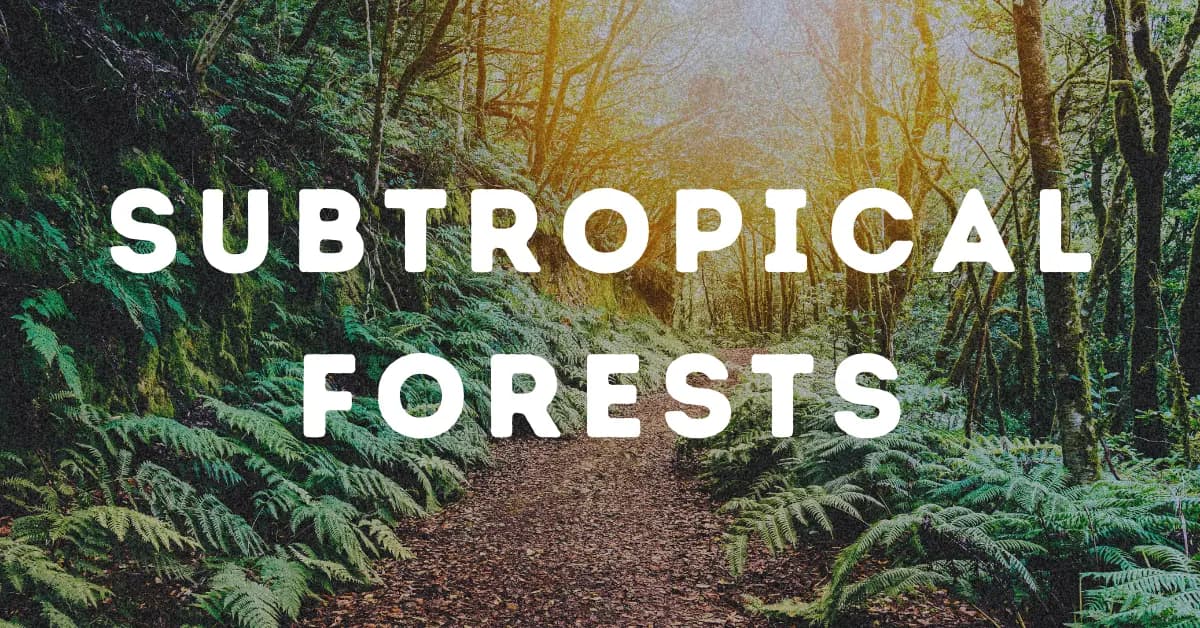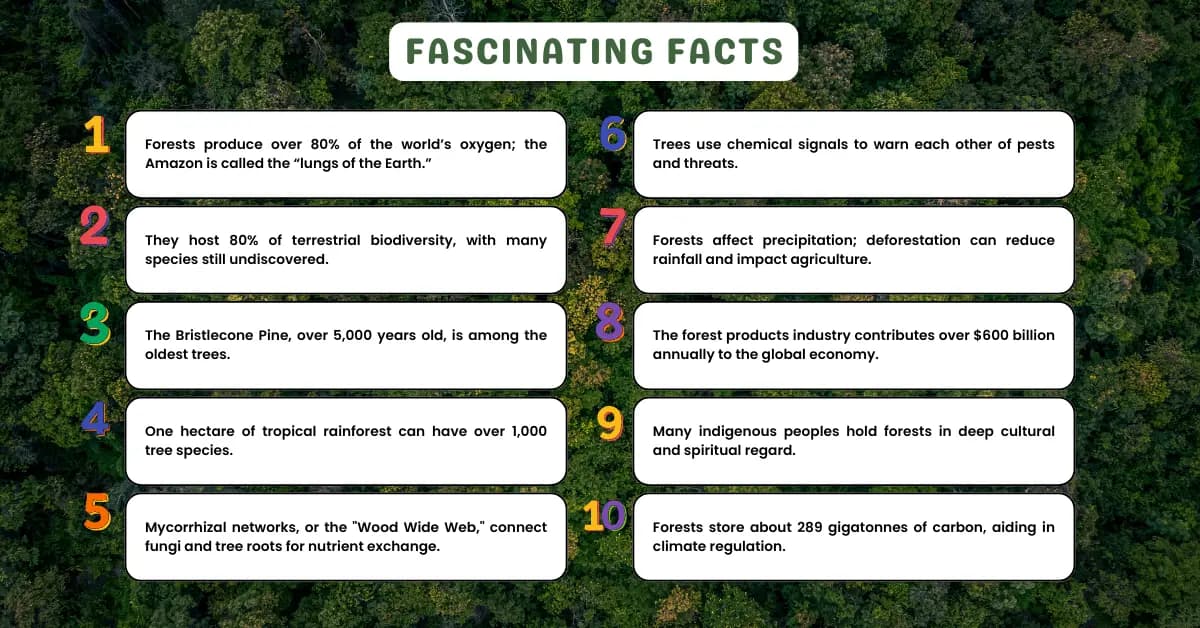A forest is the vast expansion of the land dominated by trees. They often extend over large regions. In layman’s terms, Forests are vast areas covered predominantly by trees and vegetation, forming complex ecosystems that support diverse plant and animal life.
Also, there are many different types of forests and they are classified based on factors like climate, soil type, topography, and human activities. Types of forests are tropical rainforests, subtropical forests, temperate forests, boreal forests (taiga), Mediterranean forests, and montane forests.
And just because forests are the green lungs of our planet, they play a vital role in maintaining ecological balance and supporting life. Covering about 31% of Earth's surface, they come in a rich variety of forms, each with its unique characteristics, flora, and fauna.
From the dense, biodiverse tropical rainforests to the misty, high-altitude cloud forests, all these types of forests provide essential ecosystem services and contribute to the planet's health.
This blog talks about the fascinating world of forests, highlighting unique types of forests, characteristics, locations, and biodiversity. We'll learn how climate shapes these forest ecosystems and their crucial ecological roles. Join us as we journey through diverse forests and discuss essential conservation efforts to protect these vital landscapes.
1. Tropical Rainforests

Tropical rainforests are the types of forests that are distinguished by their dense, multi-layered canopies, perpetually high humidity, and consistently warm temperatures. These lively forests are known for their amazing variety of life and rich, green landscapes. The forest structure is divided into several distinct layers: the emergent layer, towering above the rest; the upper canopy, a thick, leafy expanse; the understory, a dense, shaded realm; and the forest floor, rich with decomposing plant matter. Each layer supports a myriad of plant and animal species, each uniquely adapted to thrive in its specific environment. thrive in its specific environment.
2. Subtropical Forests

Subtropical forests are defined by their warm temperatures and moderate to high humidity. These forests typically blend evergreen and deciduous trees, resulting in a diverse and dynamic canopy. Vegetation in subtropical forests is well-adapted to handle periodic dry spells and includes broad-leaved trees, resilient shrubs, and a vibrant array of flowering plants. These types of forests are known for their lush greenery, subtropical forests boast a rich tapestry of plant diversity, creating a verdant and thriving environment.
3. Temperate Forests

Temperate forests have clear seasons and a moderate climate. They include both deciduous trees, which lose their leaves each year, and evergreens, creating a diverse and lively canopy. The forest floor is often blanketed with a rich layer of leaf litter, which plays a crucial role in nutrient cycling. Vegetation varies widely depending on the specific type of temperate forest, ranging from broad-leaved hardwoods to coniferous evergreens, each contributing to the forest’s diverse and evolving landscape.
4. Boreal Forests (Taiga)

Boreal forests, or taiga, are defined by their cold, harsh climate and prevalence of coniferous trees. These forests have a relatively straightforward structure, with a canopy dominated by needle-leaved evergreens such as spruce, fir, and pine. The undergrowth remains sparse due to the frigid temperatures and brief growing season. The soil in boreal forests is generally acidic and nutrient-poor, a result of the slow decomposition of organic matter in the cold environment.
5. Mediterranean Forests

Mediterranean forests are adapted to hot, dry summers and mild, wet winters. Vegetation here is drought-resistant and includes both evergreen and deciduous species. Plants in these types of forests often feature thick, leathery leaves, aromatic oils, and deep root systems to endure prolonged dry spells. The canopy is typically open, allowing sunlight to reach the undergrowth, which is filled with hardy shrubs and grasses that thrive in these challenging conditions.
6. Montane Forests

Montane forests are high-altitude woodlands found in mountainous regions. Nestled between lowland forests and the treeless alpine tundra, these forests showcase a striking diversity of plant life. As elevation increases, so too does the character of the forest, with vegetation adapting to cooler temperatures and varying precipitation. While some montane forests boast dense canopies, others exhibit a more open structure, influenced by factors like altitude and specific location.
7. Cloud Forests

Cloud forests, also known as fog forests, are noted for their unique climatic conditions and high atmospheric moisture. Persistent cloud cover or fog at the canopy level creates a humid environment, even with low actual rainfall. The vegetation here is specially adapted to high humidity and cooler temperatures, featuring many epiphytes such as mosses, ferns, and orchids that thrive in these moist, misty conditions.
Balance and Life
Forests play critical roles in maintaining ecological balance and supporting life through various functions:
- Carbon Sequestration: Forests serve as vital carbon sinks, absorbing atmospheric carbon dioxide and aiding in climate change mitigation. This function is essential for managing global temperatures and CO2 levels.
- Water Regulation: By capturing and storing moisture, forests play a key role in regulating river flows and replenishing groundwater. Their presence helps prevent flooding and ensures clean water supplies.
- Soil Protection: The root systems of forests stabilize soil and reduce runoff, thereby preventing erosion. This contributes to soil fertility and supports agricultural productivity.
- Habitat Provision: Forests offer essential habitats for a wide variety of species, providing food, shelter, and breeding grounds that are crucial for maintaining forest biodiversity.
- Climate Regulation: Forests impact both local and global climate patterns by influencing temperature, humidity, and precipitation, thereby helping to stabilize regional climates.
- Recreation and Cultural Value: Beyond their ecological roles, forests provide spaces for recreation and hold cultural significance for many communities, supporting outdoor activities, spiritual practices, and traditional customs.
Human Impact and Conservation
From deforestation and climate change to pollution and overharvesting, these impacts jeopardize the forests and the biodiversity and ecological functions they support. Understanding these challenges is crucial for developing effective conservation strategies to preserve these essential forest ecosystems.
Human Impact
Human activities have dramatically affected forests worldwide, leading to significant environmental and ecological challenges. Here’s a look at the primary human impacts:
1. Deforestation
- Statistics: Over 10 million hectares (about 25 million acres) of forest are lost each year due to deforestation (FAO, 2020).
- Consequences: Deforestation reduces forest biodiversity, disrupts forest ecosystems, contributes to soil erosion, and increases greenhouse gas emissions.
2. Climate Change
Shifts in temperature and precipitation patterns affect forest health, alter species distributions, and increase the frequency and severity of forest fires.
3. Pollution
- Types: Air pollution (e.g., sulfur dioxide, nitrogen oxides) and water pollution (e.g., heavy metals) affect forest ecosystems.
- Impact: Pollutants can damage trees, contaminate soil and water, and disrupt plant and animal health.
4. Land Conversion
- Effects: Conversion of forests to agricultural lands, urban areas, and infrastructure reduces forest connectivity and fragments habitats.
- Impact: Habitat fragmentation can isolate wildlife populations, making it difficult for species to migrate, find food, and reproduce.
Forest Conservation Efforts
To mitigate the impact of human activities on forests, several forest conservation strategies are employed. Biodiversity varies significantly across different types of forests due to variations in climate, vegetation, and habitat structure.
1. Tropical Rainforests: Known for their immense rich biodiversity, these forests are home to a vast array of plant and animal species. Their complex vertical structure creates numerous niches for diverse organisms.
2. Forests: Although slightly less diverse than tropical rainforests, subtropical forests still boast a rich variety of species. Plants and animals here are adapted to seasonal variations in moisture.
3. Temperate Forests: These forests exhibit moderate biodiversity, featuring a mix of deciduous forest and evergreen species. Seasonal changes impact the presence and behavior of various organisms.
4. Boreal Forests (Taiga): Biodiversity is more limited in these cold-climate forests, with flora and fauna specialized to endure harsh conditions and long winters.
5. Mediterranean Forests: Adapted to dry climates, these types of forests support a range of drought-resistant species. The unique weather conditions favor specialized plants and animals.
6. Montane Forests: Biodiversity in montane forests shifts with altitude, supporting species adapted to cooler temperatures and varying moisture levels at different elevations.
7. Cloud Forests: The high humidity and cool temperatures of cloud forests foster a rich biodiversity, including many specialized epiphytes and unique bird species adapted to the misty environment.
Key Statistics on Forest Conservation
- Protected Forest Area: As of 2024, approximately 21% of the world's forest area is protected under various forest conservation designations (IUCN).
- Reforestation Goals: Global reforestation initiatives aim to restore 350 million hectares of degraded land by 2030 (Bonn Challenge).
- Community-Based Projects: Studies show that community-managed forests can be up to 50% more effective in conserving forest biodiversity compared to state-managed forests (World Resources Institute).

Looking Ahead
Future trends highlight the evolving relationship between humans and forests:
-
Technological Advancements: Innovations like remote sensing and AI will enhance forest conservation through precise monitoring and management.
-
Climate Change Impacts: Climate change may shift forest types northward, affecting species and forest ecosystems by 2100.
-
Reforestation Success: By 2030, major reforestation projects aim to restore millions of hectares, boosting forest biodiversity and carbon capture.
-
Urban Forests: Urbanization will increase the integration of green spaces in cities, improving air quality and quality of life.
-
Global Awareness: Growing environmental awareness will likely lead to a stronger global commitment to forest conservation and sustainable practices.
Final Thoughts
Forests are more than just a collection of trees; they are complex ecosystems that sustain life, regulate climate, and support countless species. From the vibrant biodiversity of tropical rainforests to the serene beauty of cloud forests, all these types of forests play a unique role in the web of life on Earth.
